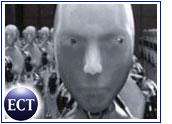
At this perplexing time in the evolution of mankind, when morality is under extreme magnification, it will be a welcome relief today to be able to escape those dilemmas for a future one — that being robots who kill.
Being the underlying theme of the potential summer blockbuster movie, “I, Robot,” the script, based on Isaac Asimov’s story and starring Will Smith, offers the premise that if one robot can kill, the chances are that all robots might be getting ready to take over.
Well, one should remember that Asimov was a seer of the 1950s, and now, in the real world, one is already wondering if the mouse-clicking, submit-button generation is being robotized by continually being the extension of commands issued by cold, calculating machines.
If so, the future is already here, and some of us may already be becoming bio-robots. Nevertheless, we are all both fascinated and repelled by this form of ultimate control and undoubtedly will be compelled to see this hot summer event.
Robot Animation
As it sometimes is with many special-effects movies, the stars often take second place to the effects, although if the plot of Asimov’s story is adhered to, this film could have a balance in favor of artistic vision, notwithstanding the talent of Will Smith and the cast of “I, Robot.”
As chance would have it, it was a strange coincidence — considering that the title of my new music CD is “Not for Robots” — that two weeks ago, I met the VP of projects for the studio that created the motion capture data for “I, Robot,” Scott Gagain.
Realizing that the subject of robots and robot animation holds a major fascination for both pioneers and followers of the tech revolution, I took a drive to Motion Analysis Studios in Culver City, California, to see what they are achieving, the kinds of hardware and software they use, and to get to the heart of the representation of our new “friends” — robots — and their latest movie.
No Hollywood Glam
As if the robot world has known that my CD was not for them, and was admonishing my investigations into their morality, about half a mile from the studio, the clutch in my car decided to work only in second gear. Fortunately, the force being with me, I managed to limp into a space in the studios parking lot.
Once inside the studio, I could see that their operation was purely practical. No Hollywood glam here, just a small staff of involved naturalists. I call them that because the analysis of motion that they are recording started out in the field of medicine.
This is because Motion Analysis had developed the cameras and software to help doctors of medicine analyze the general balance of patients suffering from spine and bone disorders, be it gait analysis or prosthetics.
A Cast of Thousands
Their Eagle Digital cameras can track an image at up to 2,000 frames a second and can process at 600 million pixels a second. They need almost no light to track the markers that are placed on the actors bodies, which trace their motions using EVaRT software.
Scott, after showing me how four actors can be turned into a cast of thousands by manipulating the software program in differing degrees, took me into a vast high-ceilinged room to meet the technician who recorded the data for “I, Robot,” Jeff Swenty.
Jeff gave me the lowdown on the system, showing me how the movements are created into 2-MB files, using more than 2 GB of RAM. Due to the markers being just points of movement, the units of hard drive space used is quite small, and the information can instantly be played back to the film director on the set.
Beyond the Scope of the Human Frame
That allows the director to compensate so the real actors will fit the movement of the data. Once both recordings are completed, the digital animation studio combines the real image with the motion analysis data to create life-like actions that are often beyond the scope of the human frame, and that will easily make an audience suspend their disbelief.
Well, much more the wiser, and convinced that I should wait to get a better digital camera, I climbed into my car and made it back to Hollywood, using second and fifth gear on the freeway. When I got to my garage, the mechanic tested the clutch, and, in his friendly yet thick Hispanic accent, said, “the clutch is fine.”
Well, maybe I am a little old fashioned, but somehow I must have encouraged a little robot favor.
Paul Korda’s new album “Not for Robots” is available online at PaulKorda.com. His songs have been recorded and sung by Roger Daltrey, Frankie Valli, Dave Edmunds, Allan Holdsworth, Robert Palmer, Italy’s Patty Pravo and many others, with sales in excess of 20 million copies.













































